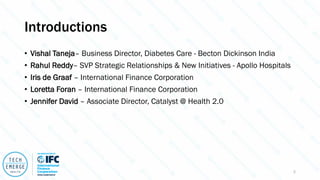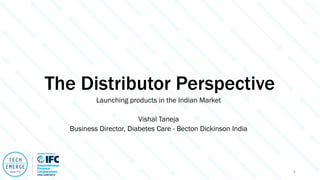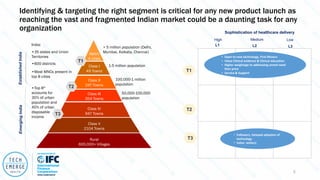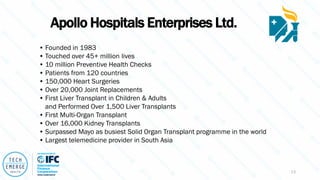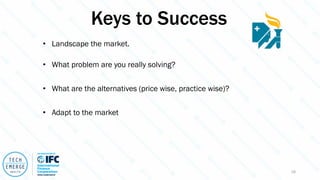Tech emerge webinar2 planning
- 1. Planning for Success TechEmerge Innovator Bootcamp Series Webinar #2 In partnership with: Powered by:
- 2. Introductions • Vishal Taneja– Business Director, Diabetes Care - Becton Dickinson India • Rahul Reddy– SVP Strategic Relationships & New Initiatives - Apollo Hospitals • Iris de Graaf – International Finance Corporation • Loretta Foran – International Finance Corporation • Jennifer David – Associate Director, Catalyst @ Health 2.0 2
- 3. International Finance Corporation (IFC) IFC, a member of the World Bank Group, is the largest global development institution focused on the private sector in emerging markets. Working with more than 2,000 businesses worldwide, we use our capital, expertise, and influence, to create opportunity where it’s needed most. In FY15, our long-term investments in developing countries rose to nearly $18 billion, helping the private sector play an essential role in the global effort to end extreme poverty and boost shared prosperity. 3
- 4. The Distributor Perspective Launching products in the Indian Market Vishal Taneja Business Director, Diabetes Care - Becton Dickinson India 4
- 5. India: •35 states and Union Territories •600 districts •Most MNCs present in top 8 cities Metro 4 cities Class I 49 Towns Class II 247 Towns Class III 354 Towns Class IV 947 Towns Class V 2104 Towns Rural 600,000+ Villages > 5 million population (Delhi, Mumbai, Kolkata, Chennai) 1-5 million population 100,000-1 million population 50,000-100,000 population •Top 8^ accounts for 30% of urban population and 40% of urban disposable income Identifying & targeting the right segment is critical for any new product launch as reaching the vast and fragmented Indian market could be a daunting task for any organization Sophistication of healthcare delivery LowMediumHigh L1 L2 L3 T1 T2 T3 EstablishedIndia T1 EmergingIndia T2 T3 • Open to new technology, First Movers • Value Clinical evidence & Clinical education • Higher weightage to addressing unmet need then price • Service & Support • Followers, Delayed adoption of technology • Value seekers 5
- 6. • Key Opinion Leaders – They are Pioneers to adopt any new products, services or technology. It is important to engage them (Advisory Boards) to understand how the new product will meet the expected need gaps. • Key unmet need addressed • Unique Product Offering • Price- Value Matrix • Market Access • Need to identify the best possible Channel(s) to make the product available • Adoption - New customers addition • Focus on working with prescribers and providers to achieve early, strong positioning in the dynamic market • Conversion/ Adoption Funnel management • % Users in first year of launch • Adherence/ stickiness of the brand • % Retention - Retaining users as loyal repeaters While the product launch and marketing efforts are critical for any new product launch, it is important to understand the criteria to define the success of new product launch 6
- 7. Companies need to advance their conventional perspective to relevant, insightful and actionable KPIs to track success Relevant, Insightful and Actionable KPIs to define and track launch/pilot success Aligned and Prepared Organization Trained Teams Hiring & Training Speed to Conversion Pertinent Value Proposition Buyer Perception Brand/ Message Recall Barriers to Use/ Prescribe Time to Adoption Training and In servicing Needs Full Account Adoption Patient Satisfaction Patient Refill Rates Product Performance Effective Stakeholder Engagement KOLs Reached KOL Message Media Noise Nurses/ Technicians Engaged Patient Groups Engaged New Customers Engaged. Source: Succeeding with the Right Key Performance Indicators (KPIs) 2011. IMS Health 7
- 8. Distribution in India is a challenge because of the large distances and the location of centers of population Town classification for India Number of outlets by industry Automobiles 2,000 – 3,000 Consumer durables 8,000 – 10,000 Mobile Phones 80,000 – 100,000 Pharmaceuticals 350,000 GSM Carriers (SIM cars, recharge coupons) 500,000 Beverages 1,100,000 FMCG excl. tobacco shops 5,500,000 FMCG incl. tobacco shops 7,500,000 Key distribution highlights • Value of organized retail highly concentrated in top cities • Top 6 cities – 68% • Top 10 cities – 85% • Beverages distribution done through road transport using trucks & vans with limited cold chain facilities • Average time taken from factory to regional warehouses – 1-2 days India: •35 states and Union Territories •600 districts •Most MNCs present in top 8 cities •Top 8^ accounts for 30% of urban population and 40% of urban disposable income Metro 4 cities Class I 49 Towns Class II 247 Towns Class III 354 Towns Class IV 947 Towns Class V 2104 Towns Rural 600,000+ Villages > 5 million population (Delhi, Mumbai, Kolkata, Chennai) 1-5 million population 100,000-1 million population 50,000-100,000 population 8
- 9. For Consumer Goods companies in India, the flow of goods varies depending upon the channel serviced Characteristics C&F Agent / Super-stockist Stockist / Wholesaler Retailer Role • Involved in the business of re-distribution to authorized distributors • Responsible for warehousing, transport of goods to next tier, payment collection • May be non-exclusive, but have separate set-up for each business • Typical margins: 1.5% to 2.0% • Involved in the business of re- distribution to wholesalers and retailers • Stockists that cater exclusively to organized retail are known as Modern Trade Stockists • Typical margins: 5% to 7% • Includes all classes of retail outlets • Involved in counter sales only; no re-distribution • Not exclusive to business • Typical margins: 10% to 15% Resources • High financial strength with ability to hold stocks • Infrastructure – Office, IT capability, warehouse space • High financial strength with ability to hold stocks and provide credit in the market • Infrastructure – IT capability, warehouse space, delivery units • Limited spend on localized sales & promotion • Appropriate store location & size Manufacturer Consumer C&F Agent C&F Agent C&F Agent C&F Agent Modern Trade DC Modern Trade Stockist Stockist Natl / Region Chain Retailer Retailer RetailerStockist Wholesaler Modern Trade Retail Channel Traditional Trade Retail Channel 9
- 10. India’s retail environment (like most fragmented markets) is characterized by significant levels of complexity forcing companies to use a multi-tier distribution network to reach a large number of retailers Large Industry size • Approx USD 180bn or INR 800,000 cr Fast pace of growth • Overall growth of ~20% pa • Organized retail growing at ~ 35% pa Unorganized dominance • > 95% of Indian retail is through the unorganized sector • Multitude of outlet types enhance complexity Fragmented structure • Largest outlet base – 12mn outlets • Number of FMCG outlets increasing at ~8% annually Multi-tier distribution • Effective (& low cost) servicing through a layered structure • Objectives of trade intermediaries are not uniform Heterogeneous retailers • Multitude of outlet types enhance complexity • Channel strategies are rarely data based 10
- 11. • Engagement Programs • Treat Distributors as Partners • Ensuring ROI as per Agreement • Training & Servicing Post Sales • Supplies & Inventories • Investments into Increasing Business • Customer Support & Complaint Handling • Claim Settlement • Build Mutual Trust Building relationships with distributors and post sales relationships 11
- 12. The Hospital Perspective Rahul Reddy SVP Strategic Relationships & New Initiatives - Apollo Hospitals 12
- 13. Apollo Hospitals Enterprises Ltd. • Founded in 1983 • Touched over 45+ million lives • 10 million Preventive Health Checks • Patients from 120 countries • 150,000 Heart Surgeries • Over 20,000 Joint Replacements • First Liver Transplant in Children & Adults and Performed Over 1,500 Liver Transplants • First Multi-Organ Transplant • Over 16,000 Kidney Transplants • Surpassed Mayo as busiest Solid Organ Transplant programme in the world • Largest telemedicine provider in South Asia 13
- 14. Clinical Excellence • Among the world’s best, in terms of outcomes • Pioneers of clinical excellence in India • Driven by skilled doctors & detailed protocols • 8 JCI accredited hospitals • Revolutionary scorecard - ACE@25, which evaluates 25 quality indicators benchmarked against the world’s best published outcomes • Patients from 120 countries 14
- 15. Keys to Success • Landscape the market 15
- 16. Keys to Success • Landscape the market • What problem are you really solving? 16
- 17. Keys to Success • Landscape the market. • What problem are you really solving? • What are the alternatives (price wise, practice wise)? 17
- 18. Keys to Success • Landscape the market. • What problem are you really solving? • What are the alternatives (price wise, practice wise)? • Adapt to the market 18
- 19. Keys to Success • Landscape the market • What problem are you really solving? • What are the alternatives (price wise, practice wise)? • Adapt to the market • Level of commitment 19

